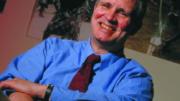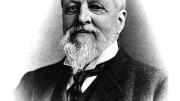Quality of life and academic matters receive equal billing in a four-part program for the Graduate School of Arts and Sciences (GSAS) spelled out by its new dean, professor of anthropology Peter T. Ellison. In a brief presentation to the Faculty of Arts and Sciences (FAS) in December, Ellison, who became dean July 1, highlighted implementation of the new financial-aid system (of which he was the architect in 1997); better instruction for graduate students in teaching and research techniques; and a looming housing crunch.
In a subsequent interview, Ellison put those priorities in broader context. The GSAS, he noted, now enrolls some 3,500 students in 39 FAS departments and in 11 doctoral programs--ranging from information technology management to medical sciences--conducted jointly with other Harvard faculties. In this sense, he said, GSAS is the only Harvard school operating University-wide. (His own environs nicely embody this interdisciplinary reach. Ellison's office, on the fifth floor of the Peabody Museum, is decorated with a vase full of arrows and with photomurals of their makers, the Efe Pygmies from the Congo, one of the peoples he has studied in his research on human reproductive physiology. Beneath his window is the excavation for the new Bauer Life Sciences Building and its genomics laboratory.)
Under the enriched financial-aid program for qualifying applicants, adopted in 1998 and phased in during the past two years, most graduate students in the humanities and social sciences receive a standard aid package. It typically guarantees five years of tuition; four years of living support--about $15,000 for each 10-month school year--consisting of two years of direct stipends and two years of teaching fellowships; and one year of summer support. In addition, students may compete for dissertation fellowships, to allow them to finish their research and writing, in lieu of teaching income. This package helps make Harvard more competitive with peer graduate schools that are often trying to attract the same promising students, Ellison indicated. In the sciences, GSAS and individual departments generally join to provide first-year support; thereafter, students are funded by research and training grants.
But Ellison sees several challenges facing GSAS's financial-aid regime, now budgeted at some $25 million per year. Much of the recent boost in stipends and fellowships depends on unrestricted FAS monies; he hopes to replace that, over time, with dedicated funding, to the tune of $100 million of additional endowment. A like sum is needed to complete funding of support in the humanities and social sciences. And he envisions raising a third $100 million to make comparable improvements in Harvard's aid for natural-science graduate students, reflecting both intense competition for the best candidates and anticipated growth in the sciences faculty ranks--a high FAS priority. (One sign of the competition: in January, Princeton initiated fellowships and stipends for all first-year science and engineering graduate students.) Accompanying that growth will be additional graduate students in need of support during their first year, before research grants take up the burden.
Apart from these purely academic financial concerns, the local housing market threatens to undo the recent enhancements in student aid. Cambridge rents have increased at "Brazilian-style" inflation rates since the phasing out of rent control, Ellison said, and vacancy rates have plummeted. These conditions prevail in all the surrounding communities.
At present, he told his fellow faculty members in December, "ninety percent of our graduate students live within one zip code" of Harvard Yard. (Ellison speaks from experience: while completing his doctoral studies, in 1983, he lived in Somerville.) "We have taken that for granted," he said subsequently. From that proximity stem unacknowledged benefits such as evening availability of teaching fellows to meet with undergraduates whom they lead in sections; round-the-clock engagement in laboratories and libraries; and, in general, involvement with the academic community. Now, those benefits are at risk.
Harvard houses about 30 percent of GSAS students, Ellison estimated. First-years are guaranteed dorm rooms (in Conant and Perkins Halls, on Oxford Street, and the nearby Child and Richards Halls). That accommodation is essential for international students, who make up one-third of the enrollment; about 350 of the 550 students in each entering class use a dorm, but this year, the demand exceeded the 400-bed supply. Another 600 graduate students reside in Harvard-owned housing units, such as Peabody Terrace, all offered at market rental rates. The rest fend for themselves.
To satisfy demand, Ellison said, Harvard would ideally have space for 60 to 70 percent of graduate students, implying the need for a doubling of rooms and affiliated apartment spaces--another 1,000 beds. That would perhaps be less expensive, and surely less subject to market shocks, than increasing stipends so students can afford commercial rentals.
Equally important, housing--which is already an issue in faculty recruitment--is emerging as a factor in enrolling students, Ellison said. Other top-tier graduate schools in expensive urban markets, such as MIT, Stanford, and Berkeley, are renovating or constructing new units for student use. Schools that can't guarantee housing along with tuition and fellowship grants, he predicted, "will find themselves on the phone addressing some very pointed questions" from desirable students each spring.
For GSAS those factors make it urgent to find additional space nearby and, in the long run, to include new graduate-student housing in the development planned for Harvard's Allston land (see "The Politics of Campus Planning,"). With adequate foresight, Ellison told his colleagues, such facilities could go beyond mere dorm space to become the equivalent of the undergraduate Houses, integrating graduate students in the life of the academic community more broadly.
Given a place to live and food to put on the table, how should students' course of study be improved? Ellison focused on two enhancements. First, now that teaching fellowships are guaranteed, GSAS can begin to organize that experience "more thoughtfully." Thus he envisions making teacher training part of students' curriculum, alongside their immersion in a discipline and the acquisition of research skills. Although the Bok Center for Teaching and Learning offers general instruction in how to lecture or evaluate student papers, the need exists for more specialized training within each discipline. The English and psychology departments, among others, require their graduate students to learn about such matters as how to mount a new course, create a syllabus, and conduct appointments with undergraduates. To encourage such instruction in other departments, Ellison said, GSAS will provide initial funding for faculty members to develop appropriate courses. (Ellison's own skill in this area has earned him a Harvard College Professorship, a specially endowed, five-year honor conferred by FAS for distinguished teaching.)
He also highlighted ways to improve students' academic experience. "We are trying to equip people to be leading scholars, scientists, teachers, and thinkers," he said, but "research skills are acquired in different ways in the different disciplines." Science students usually apprentice with a faculty member, working on research problems and learning the needed skills at the same time. But humanities and many social-science students pursue a "lonelier enterprise," first acquiring a broad body of knowledge before beginning to apply that learning to research and, ultimately, a dissertation.
"Moving some of that research training earlier in a student's career," Ellison said, would be useful for several reasons. It would "help with the transition to scholarship," equipping students to undertake doctoral research sooner. It would establish essential mentoring relationships, rather than making the first two years of study such a monastic experience. And it would expose students to academic collaboration--long a hallmark of science, and increasingly the mode in other disciplines as well, in place of the "more old-fashioned notion that all humanistic scholarship is solitary." Again, GSAS intends to seed faculty-student collaborations, beginning in the next academic year, hoping that they will flourish widely.
In all these areas, Ellison told the faculty, given vision and will, Harvard has the opportunity to sustain and enhance graduate study--indeed, "to do something significant."






